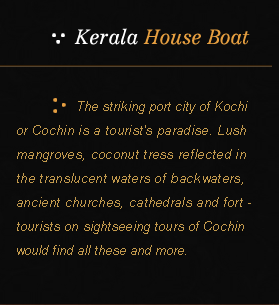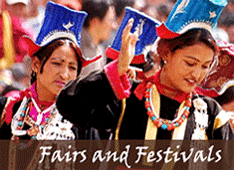
Location : Delhi - Pachewar - Bundi - Chittaurgarh - Udaipur - Jojawar - Kumbhalgarh - Ranakpur - Siana - Jaisalmer - Osiyan - Jodhpur - Chandelao - Pushkar - Jaipur - Agra - Delhi
Delhi Arrival:
COMPANY REPRESENTATIVE will receive you on arrival at the DELHI AIRPORT and transfer to your hotel.
DELHI, the capital of kingdoms and empires is now a sprawling metropolis with a fascinating blend of the past and the present. It is a perfect introduction to the composite culture of an ancient land. A window to the kaleidoscope - that is India.
Overnight will be at Delhi.
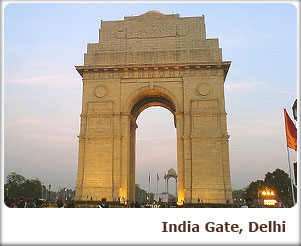 Day 02
Day 02 Delhi
After breakfast proceed for a day sightseeing tour of the city.
The city is dotted with historic monuments that are the most popular tourist attractions in Delhi. Apart from the monuments, there are museums, markets, gardens and eating joints that you can visit on your tour of Delhi. Some of the important sightseeing places in Delhi are given below.
INDIA GATE: It is the war memorial dedicated to Indian soldiers, who died during World War I. The name of many soldiers who died during World War I is inscribed on its wall. Edward Lutyens, the man who planned and built New Delhi, designed India Gate. Almost every foreign tourist visits the monument. 'Amar Jawan Jyoti', the eternal flame is added later. The eternal flame runs on gas and is a tribute to soldiers who lost their lives in the service of the nation.
RED FORT: Located in Old Delhi, the Red Fort or Lal Quila is a popular tourist attraction in Delhi. The fort was built by the Mughal emperor Shah Jahan in 1648, when he moved his capital from Agra to Delhi. The construction of the Fort started in 1638 and it was completed 10 years later in 1648. Some of the important spots inside the Red Fort include royal baths or Shahi hamams, Shahi Burj, Moti Masjid or the Pearl Mosque, Diwan-e-Aam and Diwan-e-Khas.
JAMA MASJID: The largest mosque in India, the Jama Masjid was built by Shah Jahan 1656 AD. About 5,000 laborers and craftsmen worked for six years to complete the monument. The mosque can accommodate about 25,000 people. The mosque is located in the old Delhi. The domes are built in white marble. The prayer hall of the mosque has 260 pillars.
OLD FORT: Old Fort or Purana Quila as it is called is located near Pragati Maidan on the Mathura Road. You can club a visit to the Old Fort with your tour of Red Fort and Jama Masjid as the three monuments are located in Old Delhi and are not too far from one another. Humanyun’s started the construction of the fort in 1533 AD, but before the completion of the fort, Sher Shah Suri defeated him and captured Delhi. Sher Shah Suri completed the fort and named it -Shergah. He added many structures to the fort, of which Qila-I-Kuhna Mosque and Sher Mandal are worth mentioning. In 1555, Humanyun’s re-captured Delhi and converted Sher Mandal into a library.
HUMANYUN’S TOMB: Humanyun’s Tomb is mausoleum of the Mughal emperor Humanyun’s. Bega Begum also known as Haji Begum, wife of Humayun constructed the mausoleum for her husband. The tomb was built between 1562 and 1572 AD. The tomb was designed by Mirak Mirza Ghiyuth.
QUTAB MINAR: The construction of the Qutab Minar was stated by Qutub-ud-din Aibak in 1199 AD but he died before completing it. His son-in-law and successor Iltutmish completed the construction of the building. Qutab Minar is located in Meharauli.
LOTUS TEMPLE: Also known as the Bahai Temple, the monument was opened to public only in 1986. Located near Nehru Place, the Lotus Temple is designed like a lotus flower. If you are looking for some moments of peace and tranquility in the crowded city, Lotus Temple is the ideal place to visit.
Apart from the above-mentioned sightseeing options, there are various other tourist attractions that you can visit on your tour of Delhi. Some other sightseeing places in Delhi include Lodi Gardens, National Museum, Jantar Mantar, Dilli Haat and the Garden of Five Senses.
Overnight will be at Delhi.
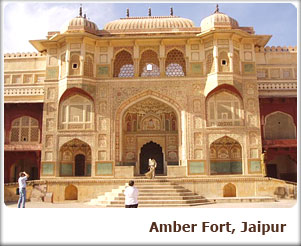 Day 03
Day 03 Delhi – Jaipur
By Deluxe Train
Jaipur – Pachewar:
By Road 90Kms/1.5hrs
Early morning you will be transferred to the railway station to board train for Jaipur. Reach Jaipur and drive to Pachewar. Reach Pachewar and check into the hotel.
Pachewar – India. A great land of culture offers equally great destinations like Rajasthan, where valour, chivalry and royalty have played a great deal in shaping the glorious traditions of its land and people.
Pachewar – 90 Kms away from Jaipur capital of Rajasthan, is a mute yet vibrant, silent but lively village, once ruled by Khangarot Rajputs, a subclan of Kachhawas-the rulers of erstwhile Jaipur State. Thakur Anoop Singh Khangarot, then Qiledar of Khandar, captured the fort of Ranthambhore from the Marathas and annexed it into Jaipur State. To reward his exemplary courage and loyalty to Maharaja Sawai Madho Singh-I of Jaipur granted him the fief of Pachewar in 1758, A.D.
Fort of Pachewar, 300 years old fort of picturesque Pachewar has now been converted into a luxurious heritage hotel with all modern amenities, where one can witness great traditions of royal hospitality. A well preserved tranquil fort with its massive ramparts imposing gates, intricate balconies and spacious apartments, adorned with antique frescos of exquisite beauty. To Pachewar is only 25 minutes drive from Dudu a small town – situated on Jaipur-Ajmer National Highway on Dudu-Malpura road, renowned for its traditional textiles.
Overnight will be at Pachewar.
Day 04
Pachewar
Breakfast will be at the hotel.
Explore rural village life.
The itinerary of local sightseeing includes a visit to the royal cenotaphs, built on the banks of Pumpa Sagar Lake, ancient temples and intimate exposure to the village – life, where you can watch the village craftsmen and artisans creating delicate blue pottery, cozy carpets, colourful tie and dye, and terracotta. Nomadic ‘Gadia-Luhars’ (iron-smiths) tempering the red-hot iron carrying their entire house-hold in a single bullock-cart can also be watched here.
Enjoy the colours of life, in a truly Rajasthani way – a synonym of hospitality intimacy and friendliness.
Overnight will be at Pachewar.
Day 05
Pachewar – Bundi
By Road 125Kms/2.5hrs
Breakfast will be at the hotel.
Drive to Bundi. Reach and check into the hotel.
The Bundi district of Rajasthan attracts tourist from all over the world. The destination provides tourist spots for both the foreign and domestic visitors. The place offers a unique culture with baoris, palaces & forts, lakes and the beautiful natural surroundings. Bundi is known for attractive step wells and tanks. These are about 50 in number and mark the town's streets and bylanes. Interesting monuments including impressive medieval forts, palaces, 'havelis', temples and 'chhatris' with elegantly carved pillars, along with a picturesque lake in the heart of the town, add to its appeal.
Relax and then proceed for the sightseeing.
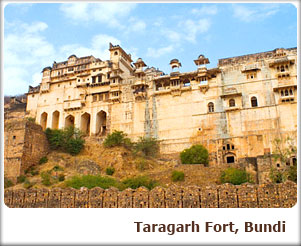 Taragarh or the Star Fort: The fort was built in 1354 A.D., and is one of the most impressive forts of Rajasthan. Located on a thickly wooded hill is a marvelous white fort with a huge reservoir, which once supplied water to the palace.
Taragarh or the Star Fort: The fort was built in 1354 A.D., and is one of the most impressive forts of Rajasthan. Located on a thickly wooded hill is a marvelous white fort with a huge reservoir, which once supplied water to the palace.The Palace: This magnificent edifice showcases the Rajput architecture. The palace houses some of the superb Bundi murals.
Chhattar Mahal or Palace or Towers: A steep, paved carafe-way is the only way to reach the monument. Of special interest in the palace is the Hazari Pol or Gate of the thousand, the Naubat Khana, the Hathi Pol with its old water clock and the Diwann-e- Aam.
Ratan Daulat: It is a very interesting structure built by Rao Raja Ratan Singh, forming a stable for nine horses and a Hatia Pol. Prior permission required to visit this place.
Chitrashala: This is an interesting pavilion and a gallery of miniature murals adorns the palace. Elaborate colorful paintings on the walls depict scenes from the 'Ragmala' and 'Raaslila'-the Radha-Krishna story.
Nawal Sagar: Visible from the fort is the square artificial lake of Nawal Sagar, broken up by islets. A temple dedicated to Varuna, the Aryan god of water, stands half submerged in the center of the lake. The reflection of the entire city and its palaces can be seen in the lake -making it a unique attraction of Bundi.
Overnight will be at Bundi.
Day 06
Bundi – Bijaipur (Chittorgarh)
By Road 110Kms/02hrs
Breakfast will be at the hotel.
Drive to Chittaurgarh. Reach and check into the hotel.
Chittaurgarh showcases the royalty and glory of Rajasthan in the form of its various magnificent forts and monuments. It is a ruined citadel where the royal past lives in the imposing forts, graceful palaces and spectacular chhatris. The entire city echoes with the tales of love and gallantry unique to the Rajput tradition. This fortified settlement has been ravaged thrice and each time the outcome was ‘Jauhar’-when women and children immolated themselves on a huge funeral pyre while men donned in saffron robes of martyrdom rode out of the fort towards a certain death.
Relax and then proceed for the sightseeing.
The Fort: The indomitable pride of Chittaur, the fort is a massive structure with many gateways built by the later Maurya rulers in 7th century A.D. Perched on a height of 180 m. high hill, it sprawls over 700 acres. The tablets and chattris within are impressive reminders of the Rajput heroism. The main gates are Padal Pol, Bhairon Pol Hanuman pol and Ram Pol. The fort has many magnificent monuments-all fine examples of the Rajput architecture. The ancient ruins of the fort are worth spending few moments in solitude.
Vijay Stambh (Victory Tower): The imposing 37 meter high structure with nine storeys, covered with exquisite sculptures of Hindu deities and depicting episodes from the two great epics - Ramayana and Mahabharata. It was built in 1440 A.D. by Maharana Kumbha, a powerful ruler of Mewar, to commemorate his victory over the Muslim rulers of Malwa and Gujarat.
Kirti Stambh (Tower of Fame): The 22 meter high tower by a wealthy JAIN merchant in the 12th century A.D. The tower is dedicated to Adinathji, The first of the Jain Tirthankaras and is decorated with figures of the Jain pantheon.
Rana Kumbha’s Palace: The ruined edifice of great historical and architectural interest, being the most massive monument in the fort of Chittaur. The palace is believed to have underground cellars where Ranio Padmini and other women committed Jauhar.
Padmini’s Palace: Built beside a pool, the palace is a magnificent one. It was here that Rana Ratan Singh showed a glimpse of queen Padmini to Alauddin Khilji. Rani Padmini stood in a ‘Zanana Mahal’- a pavilion in the centre and her reflection was visible to Alauddin Khilji in a mirror placed in the main hall. After having a glimpse of the legendary beauty, Alauddin went to extend to ravaging Chittaur in order to possess her.
Government Museum: The magnificent Fateh Prakash Mahal, presently a fine Museum with an exquisite example of sculptures from temples and buildings in the fort is worth a visit.
Jaimal and Patta Palaces: The ruins of palaces of Rathore Jaimal and Sisodia Patta are witness to the gallantry of these great warriors.
Overnight will be at Bijaipur.
Day 07
Bijaipur (Chittorgarh) – Udaipur
By Road 180Kms/05hrs
Breakfast will be at the hotel.
Drive to Udaipur. Reach and check into the hotel.
The city of Dawn, Udaipur is a lovely land around the azure lake, hemmed in by the lush hills of the ARAVALLIS. A vision in white drenched in romance and beauty, Udaipur is a fascinating blend of sights, sound and experiences and inspiration for the imagination of poets, painters and writers.
Its kaleidoscope of fairy-tale palaces, lakes, temples, gardens and narrow lanes strewn with stalls, carry the flavor of a heroic past, epitomizing valor and chivalry. Their reflection in the placid waters of the LAKE PICHOLA is an enticing sight. Udaipur is the jewel of MEWAR -a kingdom ruled by the Sisodia dynasty for 1200 Years.
Overnight will be at Udaipur.
Day 08
Udaipur
Breakfast will be at hotel.
Proceed for sightseeing tour of Udaipur, stopping first at City Palace.
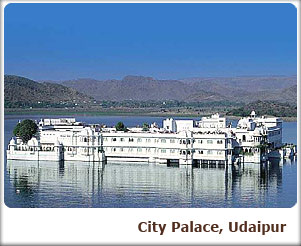 CITY PALACE: Udaipur’s fascinating City Palace is the largest royal complex in Rajasthan. Standing on a rocky promontory the palace has balconies, towers and cupolas and presents a wonderful view of the lake and the city. The complex has eleven constituent Mahals (palaces), constructed by successive maharanas during the three hundred years that followed the foundation of Udaipur in 1559. Added to this, Crystal Gallery and Durbar Hall within the complex is spectacular. Explore them for their mosaics, miniatures, mirror work and motifs.
CITY PALACE: Udaipur’s fascinating City Palace is the largest royal complex in Rajasthan. Standing on a rocky promontory the palace has balconies, towers and cupolas and presents a wonderful view of the lake and the city. The complex has eleven constituent Mahals (palaces), constructed by successive maharanas during the three hundred years that followed the foundation of Udaipur in 1559. Added to this, Crystal Gallery and Durbar Hall within the complex is spectacular. Explore them for their mosaics, miniatures, mirror work and motifs.
Here you will marvel at rooms with mirrored walls and ivory doors, colored glass windows and inlaid marble balconies and the Peacock Courtyard.
SAHELION KI BARI: The "garden of the maids of honour", Sahelion-ki-Bari was designed and laid out early in the eighteenth century as a retreat for ladies of the royal household to spend their time in leisure. The lotus pool, fountains, lawns, flowerbeds, and marble pavilions all combine to make it a captivating place.
BAGORE KI HAVELI: Situated on the picturesque bank of Pichola Lake, This Haveli was built by Shri Amarchand Badwa, who was the Prime Minister of Mewar-the rulers of Mewar Pratap Singh, Maharana Ari Singh, and Maharana Hamir Singh during the period 1751 to 1778. This palatial building reportedly has 138 rooms, balconies, terraces, courtyards and corridors. The glass and mirror inlay within the Haveli is Unique and procured in its original form. The two peacocks made with small pieces of colored glasses are unique reflection of the finest craftsmanship of glass work. What was once upon a time a living centre of nobility of Udaipur lay in darkness and ruin for nearly half a century till when it was handed over to the West Zone Cultural Centre (WZCC) in 1986.
JAGDISH TEMPLE: Built in 1651 A.D. by Maharana Jagat Singh, this Indo-Aryan temple is dedicated to Lord Jagannath, a manifestation of Vishnu. The largest and the most beautiful temple of Udaipur, it is always seething with constant activity and noted for its beautiful sculpted images and towering Shikhara.
FATEH SAGAR: West of Sahelion-ki-Bari is Fateh Sagar, a lake built by Maharana Fateh Singh. It is bordered by sharp hills and a canal built at the beginning of the twentieth century connects it to the Lake Pichola. In the middle of the lake is Nehru Park, a popular garden island with a boat-shaped cafe.
BHARATIYA LOK KALA MANDIR: Bharatiya Lok Kala Mandir is home to an attractive collection of folk dresses, puppets, ornaments, dolls, masks, folk musical instruments, folk deities and paintings. The museum is the best place for those interested in puppetry. Short amusing puppet shows are staged throughout the day. In addition, the museum runs short courses in puppet making and theatre.
Proceed for Evening Motor launch cruise on the placid waters of Lake Pichola. From the boat you will be able to view the city of Udaipur as it rises majestically above the lake in the middle of the Rajasthan desert. Also visit the Jag Mandir Palace - the other island palace in the middle of the lake. Spend some time at the Jag Mandir Palace.
JAG MANDIR: Jag Mandir, another island palace in the Lake Pichola was built by Karan Singh in 1615. It derives its name from Jagat Singh who added to the initial structure. It was never used for the purpose for it was built. This palace was used to provide shelter to the Mughal prince Khurum (later Emperor Shah Jahan) who rebelled against his emperor father Jahangir, in the 1620s. Jahangir was succeeded by Shah Jahan who was still in Udaipur at the time of his father's death. During the 1857 Mutiny this island palace once again served as a safe haven for European women and children.
Overnight will be at Udaipur.
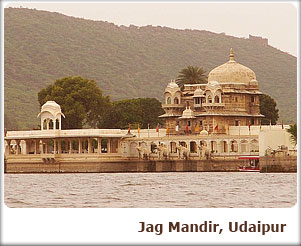 Day 09
Day 09 Udaipur – Jojawar
By Road 140Kms/03hrs
Breakfast will be at the hotel.
Proceed to Jojawar. Reach and check into the hotel.
Bestowed with the title of Rao, the nobles looked after this little fiefdom for about Two centuries after the construction in the 18th century. Known by the name of Rawla Jojawar the fort is now converted into a heritage hotel and is professionally run by Jojawar family.
A Heritage hotel, beautifully situated at the foothills of Aravalli Range, has a panoramic view of reserved game sanctuary. It’s the perfect destination for a vacationer looking for old world charm of princely fiefdoms of yesteryear. Having played host to some of the most elite guests during the British Raj the Rawla’s rich tradition of hospitality continues. The Rawla offers an amazing insight into the village life and its surroundings on the back of the famous Marwari horse. Apart from being a heaven for bird watching the village environs have rich wildlife, leopard, hyenas and sloth bears to mention a few. Set amidst the Aravalli hills, this little garrison fort was once a major principality of the Royal house of man war.
The two young sons of the present Rao and Rani Sahiba Maharaj Singh Ji, Nagendra and Amit vikram singh respectively, are looking after the hotel in the Rawla, recently restored into the old world splendor. Bother having excellent knowledge of travel trade and hotel industry, could also enhance and enlighten the guests with the keen interest in history and flora and fauna of the region.
The village of RAWLA JOJAWAR boasts of high camel population bred by the fascinating Rebaris. The vivid colors of the turbans and dresses of villagers are a treat to watch for the ever seeking traveler’s eye.
One of the other attractions when at Rawla Jojawar is the train safari which takes you through the picturesque Aravallis, passing through tunnels and bridges overlooking the beautiful lake and the forest around it. This gives you a good insight into local tribal life.
Overnight will be at Rawla Jojawar.
Day 10
Jojawar – Kumbhal Garh – Ranakpur
By Road 155Kms/03hrs
Breakfast will be at the hotel.
Proceed to Ranakpur visiting Kumbhalgarh enroute.
Kumbhalgarh Fort: Though little known, Kumbhalgarh has one of the finest examples of defensive fortifications in entire Rajasthan. Total length of the wall of this fort is 32 kilometers and there are excellent views from the top of the walls. Kumbhalgarh stands on the site of an ancient citadel dating back to the second century A.D., belonging to a Jain descendant of India's Mauryan emperors. Its steel gray ramparts encircle the fertile Shero Mallah Valley, with ancient monuments cenotaphs, ponds, and flourishing farms. In addition, a stroll along the walls of the fort gives great panoramic views.
Reach Ranakpur and check into the hotel.
Situated around 60 km north of Udaipur, Ranakpur is one of the five most important pilgrimage sites of Jainism. It is home to an exceptionally beautiful temple complex in the Aravali ranges and a must visit for the tourists coming to this region. Ranakpur is tucked away in a remote valley in the Aravali range.
Visit the RANAKPUR TEMPLES, dating back to the 15th century have 200 pillars, none of which are alike, support its 29 halls. The Temple abounds with intricate friezes and sculptures. Includes visits to two more Jain temples and the Temple of the Sun God with its erotic sculptures.
Overnight will be at Ranakpur.
Day 11
Ranakpur – Siana
By Road 100Kms/1.5hrs
Breakfast will be at the hotel.
Proceed to Siana. Reach and check into the hotel.
Siana is a small hamlet situated in south west Rajasthan, bordering the great Thar desert. The terrain here is a unique mixture of Aravalli hills bordered by sand dunes and agricultural lands. The run-off from these hills has created picturesque ravines in these dunes and has carried this sand into neighboring countryside making this area perfect for riding. The south west part of Rajasthan is still untouched by western influence and offers a good insight into the traditional way of life. The rock formations in the Aisrana Range need a special mention as they are unique and wonderful to watch against the backdrop of the setting sun.
Overnight will be at Siana.
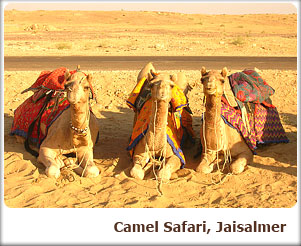 Day 12
Day 12 Siana – Jaisalmer
By Road 230Kms/05hrs
After breakfast proceed to Jaisalmer. Reach Jaisalmer and check into the hotel.
Jaisalmer, the Golden City of India, is one of the most alluring tourist destinations in Rajasthan, India. Jaisalmer is famous for its magnificent forts, enchanting palaces, havelis (mansions) and century’s old houses. Jaisalmer is also known for its exotic sand dunes and exciting camel safaris. Jaisalmer has a number of exciting tourist attractions showcasing the royal grandeur of the bygone era. The major tourist attractions in Jaisalmer include the Jaisalmer Fort, Patwon-Ki Haveli, Nathmalji-ki-haveli, Salim Singh-Ki Haveli, Tazia tower, Bar Bagh and the beautiful Gadsisar Lake. Its exquisite handicrafts and colorful festivals are other major tourist attractions.
Jaisalmer also offers exciting shopping experience to its visitors. On tours to Jaisalmer, you can shop for embroidered textiles and carpets, woolen pattu, carpets made from camel hair, tapestry, oil lamps, silver jewelry, finely cut antiques, old stonework, trinkets, and other souvenirs and curios.
Overnight will be at Jaisalmer.
Day 13
Jaisalmer
Enjoy the breakfast at the hotel and proceed for the sightseeing.
JAISALMER FORT: The 12th century Jaisalmer Fort is one of the most formidable forts in Rajasthan, India. Perched on Trikuta hill, Jaisalmer Fort is a 250 ft tall and massive fort surrounded by a 30 ft high sandstone wall with 99 bastions, offering a spectacular sight to visitors. The Fort also houses a Jain Temple.
JAISALMER HAVELIS: Once the residence of wealthy merchants, the havelis (mansions) of Jaisalmer are famous for their artistic designs and decorations. Their exclusive cutwork, yellow and red stone treatment, and the bracket-shaped decoration of peacocks, never fail to mesmerize the visitors. The Patwon-Ki-Haveli, Salim-Singh-Ki-Haveli and Nathmal ji-Ki-Haveli are major tourist attractions in Jaisalmer.
NATHMAL KI HAVELI: Two architect brothers built it in the 19th century. Interestingly, while one concentrated on the right, the other concentrated on the left and the result is a symphony epitomizing the side by side symmetry during construction. Paintings in miniature style monopolize the walls in the interior. Mighty tuskers carved out of yellow sandstone stand guard to the Haveli.
SALIM SINGH KI HAVELI: This Haveli was built about 300 years ago and a part of it is still occupied. Salim Singh was the prime minister when Jaisalmer was the capital of the princely state and his mansion has a beautifully arched roof with superb carved brackets in the form of Peacocks. The mansion is just below the hill and it is said that once it had two additional wooden storeys in an attempt to make it as high as the maharaja's palace, but the maharaja had the upper storey torn down.
PATWON JI KI HAVELI: This is one of the largest and most elaborate Haveli in Jaisalmer and stands in a narrow lane. It is five storeys high and is extensively carved. It is divided into six apartments, two owned by archaeological Survey of India, two by families who operate craft-shops and two private homes. There are remnants of paintings on some of the inside walls as well as some mirror work.
GADSISAR SAGAR LAKE: A famous picnic spot in the sandy city, Gadsisar Sagar Lake is among the most beautiful tourist attractions in Jaisalmer. It attracts hundreds of migratory birds during the winter season. Bara Bagh: Located on the bank of Gadsisar Sagar Lake, Bara Bagh is an oasis in the desert. The lush green garden provides much-needed relief to the local people.
TAZIA TOWER: The pagoda like Tazia Tower rises from the Badal Mahal (Palace of Clouds). The beautiful five-tiered tower is known for its beautifully carved balconies on each storey.
JAIN TEMPLES: These fine Jain temples were built in the 12th to 15th century, within the Jaisalmer Fort. They are beautifully carved and dedicated to Rikhabdevji and Sambhavnathji. The Gyan Bhandar, a library containing some extremely old manuscripts, is within the temple complex.
Overnight will be at Jaisalmer.
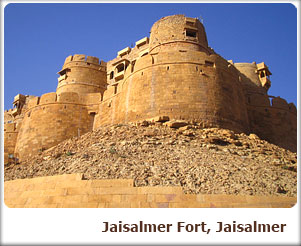 Day 14
Day 14Jaisalmer – Ossian
By Road 237Kms/05hrs
Breakfast will be at the hotel.
Proceed to Ossian. Reach and check into the hotel.
OSSIAN: Ossian, known as Ukeshpur in ancient time, is a land of temples. It was a Brahminical centre & later, Jainism also flourished here as is evident from the remnants of medieval temples. The Oswal trace their origin from this place. Ossian is a major site, containing monuments spanning five centuries of artistic evolution. There are several beautiful temples and shrines, oldest amongst them being the Sun temple. The doorway to this temple is one of the finest to be seen anywhere in India. The Harihara I temple, dating back to 750 A.D., is a 'panchayatan' temple, which means that a central shrine is surrounded by four other smaller ones. It stands on a beautifully decorated terrace with thirteen niches built into its sides. The main temple carries some excellent early figural sculptures including the Krishna Leela frieze. The Harihara III temple was built around 800 A.D. the walls of its rectangular sanctum carry exuberant decoration, tastefully executed. There is an open hall, the aisles of which have been provided with a beautiful sloping ceiling supported by rafters, shaped like 'nagas'. Harihara III is one of the finest examples in India of exuberance going hand in hand with architectural strength. Harihara II adjoining Harihara III is a somewhat less well-finished copy of Harihara I. Apart from this there is the main Sun Temples such as Mahavira temple, Vishnu temples III, IV, V, which are also worth seeing for their ancient architectural beauty. A unique feature of these temples is that most of them face the west.
Proceed to the SAND DUNES for visiting the typical Rajasthani Desert Village. View the sunset from the dunes, as the sky is set on fire. Return to the village for dinner amidst Rajasthani musicians playing haunting tunes.
Overnight will be at Ossian.
Day 15
Ossian – Jodhpur
By Road 90Kms/02hrs
Breakfast will be at the hotel.
Proceed to Jodhpur. Reach Jodhpur and check into the hotel.
Set at the edge of the Thar Desert, the imperial city of Jodhpur echoes with tales of antiquity in the emptiness of the desert. Once the capital of the Marwar state, it was founded in 1459 AD by Rao Jodha-chief of the RATHORE clan of Rajputs who claimed to be descendants of Rama - the epic hero of the RAMAYANA. The massive 15th century AD Mehrangarh Fort looms on the top of a rocky hill, soaring 125 Mts. Above the plains. The city is encompassed by a high wall -10 km long with 8 gates and innumerable bastions.
Relax and then proceed for the sightseeing.
MEHRANGARH FORT: This fort is one of the largest forts in India. The fort is situated at an altitude of about 125 metres and is spread over an area of 5 sq km, with seven gates. It has been a witness to the splendor of bygone era. The beauty and the grandeur of numerous places in the fort narrate a saga of hard sandstones yielding to the chisels of skilled Jodhpur sculptures. Mehrangarh literally means "Majestic Fort". It is located at very center of the city and is visible surrounding from the city. Originally built in 1806 the fort has been added to many times since. The palaces in this fort were built in an informal pattern over several centuries. They have their own peculiar style, with narrow staircases, serving as the only means of access to the royal residences within. A collection of musical instruments, palanquins, furniture and cannons on the fort's ramparts are well - preserved.
JASWANT THADA: Close to the fort complex lies white marble cenotaph, built in 1899 in commemoration of Maharaja Jaswant Singh II rare portraits of Jodhpur rulers are also to be seen at Jaswant Thada. A visit inside the cenotaphs, with some villagers of the region, would bring forward the reverence they still hold for their brave kings.
UMAID BHAWAN PALACE: The romantic looking Umaid Bhawan Palace was actually built with the purpose of giving employment to the people of Jodhpur during a long drawn famine. The royal family of Jodhpur still lives in a part of the palace. Another part of the palace houses a well-maintained museum, displaying an amazing array of items belonging to the Maharaja and the royal family - weapons, antiques & fascinating clocks, crockery and trophies
Visit the BISHNOI VILLAGES and have a rare glimpse into the rich culture and true essence of India. Abundant wildlife (game) and memorable moments of the great desert landscape fascinates one while driving along the countryside.
Overnight will be at Jodhpur.
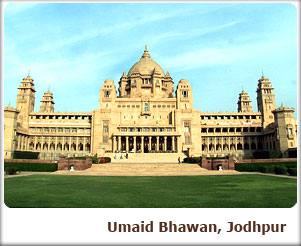 Day 16
Day 16Jodhpur – Chandelao
By Road 41Kms/01hr
Breakfast will be at the hotel.
Proceed to Chandelao. Reach and check into the hotel.
Chandelao village is situated just 40 Kms from Jodhpur city on the edge of the Thar. Still the home of descendents of Rao Kumpa, who fought against Sher Shah Suri, the Afghan ruler of Delhi and died in the battle of Sumelgiri in 1544 A.D. seeing this brave Rajput General, Emperor Sher Shah Suri said, "For a handful of Bajra, I nearly lost the kingdom of Hindustan". Chandelao Garh was built by his grandson Rao Puranmal who had annexed Sirohi for the Maharaja of Jodhpur.
Chandelao the Village: Chandelao Village is a typical Rajasthani village where you will find Bishnois, Raikas and other communities. You will see the local craftsmen at work, the potter, the blacksmith, the goldsmith and the weaver.
The village has three beautiful lakes where you will find demosille cranes, sarus and other water birds. You can also visit a medieval stepwell where village women in their traditional attire come to fetch water.
Chandelao is typical of all West Rajasthan villages. The people are friendly and highly hospitable.
Chandelao Garh: Entering into the majestic gateway of Chandelao Garh is like taking a journey into the past. You are taken into times past and the feudal splendor of this bygone era comes to life before your very eyes.
Chandelao Garh gives you personalized services, a one to one relationship. Rooms are furnished with period furniture and have an old world charm, for your comfort they are provided with all modern amenities.
The cuisine served at Chandelao Garh is a treat to be savored. We offer the best Rajasthani cuisine. Each delicacy is traditional and handed down from generations.
Overnight will be at Chandelao.
Day 17
Chandelao – Pushkar
By Road 170Kms/04hrs
Breakfast will be at the hotel.
Drive to Pushkar. Reach Pushkar and check into the hotel
Snuggled in the laps of the Aravali hills and beautified by the serene lake, Pushkar is a nature-lover's paradise. The sacred Pushkar Lake which according to a legend was created by Lord Brahma, the 52 Ghats and 500 temples has added a mythical charm to the place making it a place of Hindu pilgrimage. The illustrious cattle fair that is the largest in the world has also made Pushkar internationally famous and hence Pushkar is cited as 'the land of fairs and festivals.' Pushkar is also known as 'the rose garden of Rajasthan' because of its fragrant roses whose essence is exported all over the world. The tranquil and spiritual ambience of Pushkar, the dwindling lanes, the rooftop restaurants and the colorful fairs and festivals make a tourist fall in love with the place
Relax and then proceed for the sightseeing.
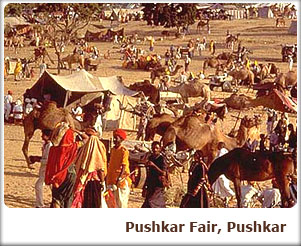 Brahma Temple: The most famous and visited tourist attraction of Pushkar is the Brahma Temple. It is the only temple of Lord Brahma (creator of the world) in the whole world. The temple was constructed in the 14th Century. It houses a life-size statue of Lord Brahma. The temple is made up of marble and is its floor is decorated with silver coins, donated by the pilgrims.
Brahma Temple: The most famous and visited tourist attraction of Pushkar is the Brahma Temple. It is the only temple of Lord Brahma (creator of the world) in the whole world. The temple was constructed in the 14th Century. It houses a life-size statue of Lord Brahma. The temple is made up of marble and is its floor is decorated with silver coins, donated by the pilgrims. Pushkar Lake: The legend behind the Pushkar Lake is that the lake originated when some Lotus petals fell on Earth from the hands of Lord Brahma. Surrounding the lake, are 52 Ghats, each having water with special powers. The Pushkar Lake also serves as the venue for the renowned Pushkar fair held every year.
Savitri Temple: The Savitri temple is dedicated to Goddess Savitri, the wife of Lord Brahma. Positioned on the Ratnagiri Hill, this temple holds a legend to itself. It is believed that once Lord Brahma had to perform a Yagna immediately. However, the performance of the Yagna required the presence of his wife. So, he married a local milkmaid, Gayatri for the purpose. When Brahma's wife, Savitri, found out, she cursed Lord Brahma that he would be worshipped only in Pushkar and only once a year. Then, she immolated herself at the Ratnagiri Hill, where the temple now stands.
Warah Temple: The Warah temple is dedicated to Lord Vishnu (preserver of the world). King Anaji Chauhan built this temple. The temple has an image of lord Vishnu in the incarnation of a wild boar. The legend has it that Lord Vishnu came took the form of a Warah (wild boar) to kill the demon Hirnayaksh.
Spend evening visiting the GHATS and the local market. The colorful and vibrant Pushkar Bazaar is a shopper's delight. One can buy great souvenirs like silver jewelry, embroidered shoes, wall hangings, shoulder bags, embroidered fabrics, decorative items and so on.
Overnight will be at Pushkar.
Day 18
Pushkar – Jaipur
By Road 145Kms/03hrs
Breakfast will be at the hotel.
Drive to beautiful Pink City – Jaipur. Reach and check in at hotel.
Jaipur is the capital of the state of Rajasthan a romantic realm of resplendent palaces, mighty fortresses and regal Maharajahs that lies in the western deserts and is an utterly unique part of India. Proudly belonging to the KSHATRIYA warrior caste and fiercely independent, the Rajput princes made fearsome foes. However, many of them realized that to maintain their wealth and authority locally, it was expedient to proclaim allegiance to the central power. Thus, many enjoyed a privileged position under the Mughal emperors and also the British Raj that followed.
The bustling Rajasthan capital of Jaipur takes its name from its venerated founder Jai Singh II, who was given the title Sawai Maharaja by the Mughal. Literally translated this would mean ’one and a quarter’, suggesting that the Mughal thought this emperor to be more valuable than just ‘one’. Jaipur is known as the ’Pink City’ on account of the distinctive color of its buildings. This did not, however, form part of the original plan, but dates back to 1856, when the city was given a wash of pink in honor of a State Visit from Prince Albert.
This evening, visit the Birla Temple to learn more about the fascinating religious life of Jaipur. The marble structure, built as recently as 1985, houses ornate statues including one of Lakshmi (goddess of Wealth and Beauty) and Narayan dressed in gaudy robes, representing a Hindu vision of heavenly luxury. Carvings in the temple and on pillars supporting the covered walkways include images of the Hindu pantheon, as well as Jesus, the Blessed Virgin Mary and St Francis of Assisi. Your visit will coincide with the AARTI Ceremony, which involves oil lamps being lit and waved, in order to awake and invoke the deity.
Enjoy the experience and spend night at Jaipur.
Day 19
Jaipur
After breakfast drive to Amber Palace. Enjoy Elephant Back ascent to the Fort.
AMER PALACE & FORT: Amer Fort and Palace was originally built by Raja Man Singh and subsequently developed by Sawai Jai Singh. The major attractions are Sheela Devi Temple, Sheesh Mahal (Hall of mirrors), Jai Garh Fort a few kilometers from the city centre was built for the defence of the town and has one of the world’s biggest cannons on wheels and a rich collection of arms and weapons.
Continue city sightseeing.
HAWA MAHAL (PALACE OF WINDS): Hawa Mahal is the most strikingly designed monument in Jaipur. Built by the Poet-King Sawai Pratap Singh in 1799, the Hawa Mahal is centrally located and is multiniched five storey high back view of the compled. It was conceived to provide an adequate vantage position behind delicate stone-carved jali, screens for the palace women to watch the royal processions passing through the Bazar below without being seen by outsiders. The Top of the palace affords a beautiful view of the city. A small archaeological museum is yet another attraction in the palace.
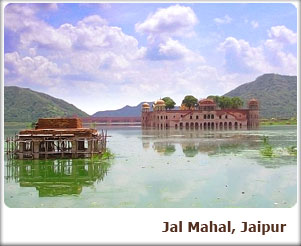 JAL MAHAL: The Jal Mahal Palace, Jaipur is noted for its intricate architecture. The Palace was developed as a pleasure spot. It was used for the royal duck shooting parties. On the road to Amber at a distance of 6.5 Kms from Jaipur are the cenotaphs of the royal family. A causeway leads to Jal Mahal Palace situated in the middle of Man Sagar Lake, opposite the cenotaphs. The first four floors of this building is under water, only the top floor remains outside. One can have a wonderful view of the lake and the palace from Nahar Garh Fort Built in 1799, the palace is now abandoned, but reasonably well preserved. In the monsoons, it looks particularly startling with its red sandstone set against the water hyacinth filled lake.
JAL MAHAL: The Jal Mahal Palace, Jaipur is noted for its intricate architecture. The Palace was developed as a pleasure spot. It was used for the royal duck shooting parties. On the road to Amber at a distance of 6.5 Kms from Jaipur are the cenotaphs of the royal family. A causeway leads to Jal Mahal Palace situated in the middle of Man Sagar Lake, opposite the cenotaphs. The first four floors of this building is under water, only the top floor remains outside. One can have a wonderful view of the lake and the palace from Nahar Garh Fort Built in 1799, the palace is now abandoned, but reasonably well preserved. In the monsoons, it looks particularly startling with its red sandstone set against the water hyacinth filled lake. THE CITY PALACE: The city Palace is a historic landmark. The Carved arches are supported by grey-white marble columns studded with floral motifs in gold and colored stones. Two elephants carved in marble, guard the entrance, where retainers whose families have served generations of the rulers are at hand, to serve as guides.
JANTAR MANTAR Jantar Mantar is one of Sawai Jai Singh’s five remarkable observatories. Constructed with stone and marble its compled instruments, whose setting and shapes are precisely and scientifically designed, represent the high-points of medieval Indian Astronomy. The two Ram Yantras used for gauging altitudes are unique in their isolation. This is the largest of five observatories founded by Sawai Jai Singh-II in various parts of the country.
This evening is free for you to relax shop or explore independently. Shopping is superb in Jaipur, particularly for gold and silver jewellery, pottery, tie-dye materials, silk, saris, wooden handicrafts and carpets.
Overnight will be at Jaipur.
Day 20
Jaipur – Fatehpur Sikri – Agra
By Road 235Kms/05hrs
After breakfast proceed to Agra visiting Fatehpur Sikri enroute.
FATEHPUR SIKRI – THE CITY OF VICTORY: 37 Kms from the city of Agra, stands Fatehpur Sikri, Akbar’s capital. Full credit goes to the Archeological Survey of India for this perfectly preserved example of a Mughal city at the height of the empire’s splendor. It is an attraction no visitor to Agra should miss. This sprawling structure is made of red sandstone and combines both Hindu and Mughal architecture. This walled city contains the mausoleum of the Sufi fakir, Saleem Chisti who is said to have granted Akbar and his Hindu queen Jodhabai their wish for a son. The main entrance to Fatehpur Sikri is through the 175 feet Buland Darwaza, the highest gateway in the world. It was built by Akbar to commemorate his victory over Khandesh in Gujarat. The Panch Mahal is a five-storeyed tower, the highest point in Fatehpur Sikri. This extremely airy tower is supposed to have been used by one of the emperor's many queens.
Continue drive to Agra. Reach and check into the hotel.
AGRA: Two great Mughal monarchs, Akbar and Shah Jahan, transformed the little village of Agra into a befitting second capital of the Mughal Empire – giving it the name Dar-ul-Khilafat {seat of the Emperor}. Today a visitor to Agra is caught up in a world of contrasting edifices, of red sandstone and white marble, narrow galleys and quaint buggies, and that irresistible charm that this favorite city of the Mughals still retains. It is not surprising, that modern Agra still reflects its Mughal heritage most conspicuously. A walk down the narrow bustling streets of the city will introduce the visitor to the wafting aroma of Mughlai cuisine.
Overnight will be at Agra.
Day 21
Agra
Enjoy breakfast at the hotel.
Proceed for day sightseeing of Agra.
THE TAJ MAHAL – AN EMPEROR’S LAMENT: Agra is the city of the Taj Mahal. It is a sublime experience of the greatest love story ever told. Today India's most fascinating and beautiful masterpiece, this perfectly symmetrical edifice is set amidst landscaped gardens on the banks of the Yamuna River. The Taj was built by the Mughal Emperor Shahjahan as a memorial to his wife, Mumtaz Mahal. After her untimely death, Shah Jahan had her mortal remains buried in this mausoleum. And after his own demise he was placed to rest next to his beloved queen in the same mausoleum. Under the dome, below the ground level, in a dimly lit chamber, lie the mortal remains of Shahjahan and his beloved queen Mumtaz, reminding the world of their undying love. The Taj remains closed for visitors on Friday
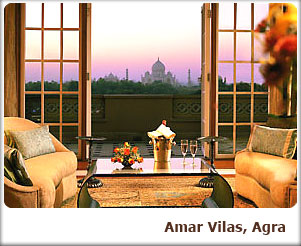 AGRA FORT – ARCHITECTURAL WONDER IN STONE: Within a radius of 3 kilometers, on the banks of the river Yamuna raises the crescent like Agra Fort. Designed and built by Akbar in 1565 A.D., the fort is surrounded by a 70 feet high wall. It houses the beautiful Pearl Mosque and numerous palaces including the Jahangir Mahal, Diwan-i-Khas, Diwan-i-Am and Moti Masjid. Later it was used by his son Jahangir also as the seat of power. Shahjahan modeled his creation, the Red Fort at Delhi on this fort. The Agra fort happens to be on the same bank of the river Yamuna as the Taj Mahal which is visible in all its beauty from one side of the fort. So very ironically, Shahjahan, a prisoner of his son Aurangzeb in his old age was put in a cell from where he could gaze at the Taj Mahal at a distance, from his cell in the Agra Fort.
AGRA FORT – ARCHITECTURAL WONDER IN STONE: Within a radius of 3 kilometers, on the banks of the river Yamuna raises the crescent like Agra Fort. Designed and built by Akbar in 1565 A.D., the fort is surrounded by a 70 feet high wall. It houses the beautiful Pearl Mosque and numerous palaces including the Jahangir Mahal, Diwan-i-Khas, Diwan-i-Am and Moti Masjid. Later it was used by his son Jahangir also as the seat of power. Shahjahan modeled his creation, the Red Fort at Delhi on this fort. The Agra fort happens to be on the same bank of the river Yamuna as the Taj Mahal which is visible in all its beauty from one side of the fort. So very ironically, Shahjahan, a prisoner of his son Aurangzeb in his old age was put in a cell from where he could gaze at the Taj Mahal at a distance, from his cell in the Agra Fort. The fort has four gates and is enclosed by a double barricaded wall of red sand stone. Many buildings were constructed within the fort of which very few remain till date. One of the most significant ones is the multi storied Jahangir Mahal built by Akbar for his wife Jodha Bai. The Mahal is reached through an impressive gateway and its inner courtyard consists of beautiful halls, profuse carvings on stone, exquisitely carved heavy brackets, piers and cross beams.
ITMAD – UL – DAULAH’A TOMB: This tomb was erected by Nur Jahan in sweet memory of her father Ghiasud-Din-Beg between 1622 - 1628 A.D. This white marble structure of the pre-Taj era though smaller is often considered equal if not better to the great one itself.
Overnight will be at Agra.
Day 22
Agra – Delhi - Departure
By Road 203Kms/05hrs
Morning enjoy the breakfast.
Drive to Delhi. Reach and enjoy last minute shopping.
As per your INTERNATIONAL FLIGHT TIMINGS you’ll be transferred to the airport to take your flight back home with sweet memories of RAJASTHAN TOUR
...........................................................................TOUR ENDS...........................................................................
INCLUSIONS:
- ACCOMODATION AT SUGGESTED HOTELS,
- DAILY BUFFET BREAKFASTS,
- AC VEHICLE WITH THE DRIVER FOR ALL TRANSFERS & SIGHTSEEING AS PER THE ITINERARY,
- MEET AND ASSIST AT THE AIRPORT/STATION ON ARRIVAL/DEPARTURE,
- ENGLISH SPEAKING LOCAL GUIDES AT PPLICABLE PLACES
- RICKSHAW RIDE IN DELHI,
- HORSE CART RIDE TO TAJ MAHAL IN AGRA,
- FATEHPUR SIKRI EXCURSION,
- ELEPHANT RIDE AT AMER FORT, JAIPUR,
- SAND DUNES CAMEL RIDE & DINNER IN OSSIYAN,
- BOAT RIDE IN LAKE PICHOLA IN UDAIPUR,
- CAMEL CART RIDE IN PUSHKAR,
- SAFARI IN SIANA,
- ALL MEALS IN SIANA,
- TRAIN SAFARI IN RAWLA JOJAWAR,
- TRAINFARE IN AC CHAIR CAR FROM DELHI-JAIPUR,
- TOLL TAXES, DRIVER ALLOWANCE, PARKING, AND
- ALL APPLICABLE TAXES AND SERVICE CHARGES.
- LUNCHES & DINNERS,
- MONUMENT ENTRANCES,
- CAMERA CHARGES AT THE MONUMENTS,
- PORTER CHARGES,
- TIPS &
- PERSONAL EXPENSES.
Copyright © Mesmerizing india. All rights reserved.

